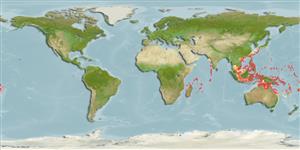Classification / Names
Common names from other countries
Main reference
Size / Weight / Age
Max length : 7.5 cm SL male/unsexed; (Ref. 48637)
Environment
Marine; reef-associated; depth range 1 - 66 m (Ref. 86942)
Climate / Range
Tropical, preferred ?
Distribution
Short description
Dorsal
spines
(total): 6 - 7;
Dorsal
soft rays
(total): 10;
Anal
spines: 1;
Anal
soft rays: 10. Characterized by pale grey body color with numerous small white dots and larger brown spots on head and body; row of four large ovate blotches along side at level of pectoral fin base; base of caudal fin with additional spot; united pelvic fins, well developed frenum present; rounded caudal fin, slightly shorter than HL; longitudinal scale series 28-29; ctenoid scales on body and nape; cycloid scales on prepectoral area, breast, cheek and opercle; predorsal scales about 12; 1-2 small spines on preopercular margin just above angle; depth of body 4.2-4.7 in SL (Ref. 90102).
IUCN Red List Status (Ref. 115185)
Threat to humans
Harmless
Human uses
More information
Common namesSynonymsMetabolismPredatorsEcotoxicologyReproductionMaturitySpawningFecundityEggsEgg development
Age/SizeGrowthLength-weightLength-lengthLength-frequenciesMorphometricsMorphologyLarvaeLarval dynamicsRecruitmentAbundance
ReferencesAquacultureAquaculture profileStrainsGeneticsAllele frequenciesHeritabilityDiseasesProcessingMass conversion
Tools
Special reports
Download XML
Internet sources
Estimates of some properties based on models
Phylogenetic diversity index
PD50 = 0.7500 many relatives (e.g. carps) 0.5 - 2.0 few relatives (e.g. lungfishes)
Trophic Level
3.3 ±0.3 se; Based on size and trophs of closest relatives
Resilience
High, minimum population doubling time less than 15 months (Preliminary K or Fecundity.)
Vulnerability
Low vulnerability (21 of 100)
Price category
